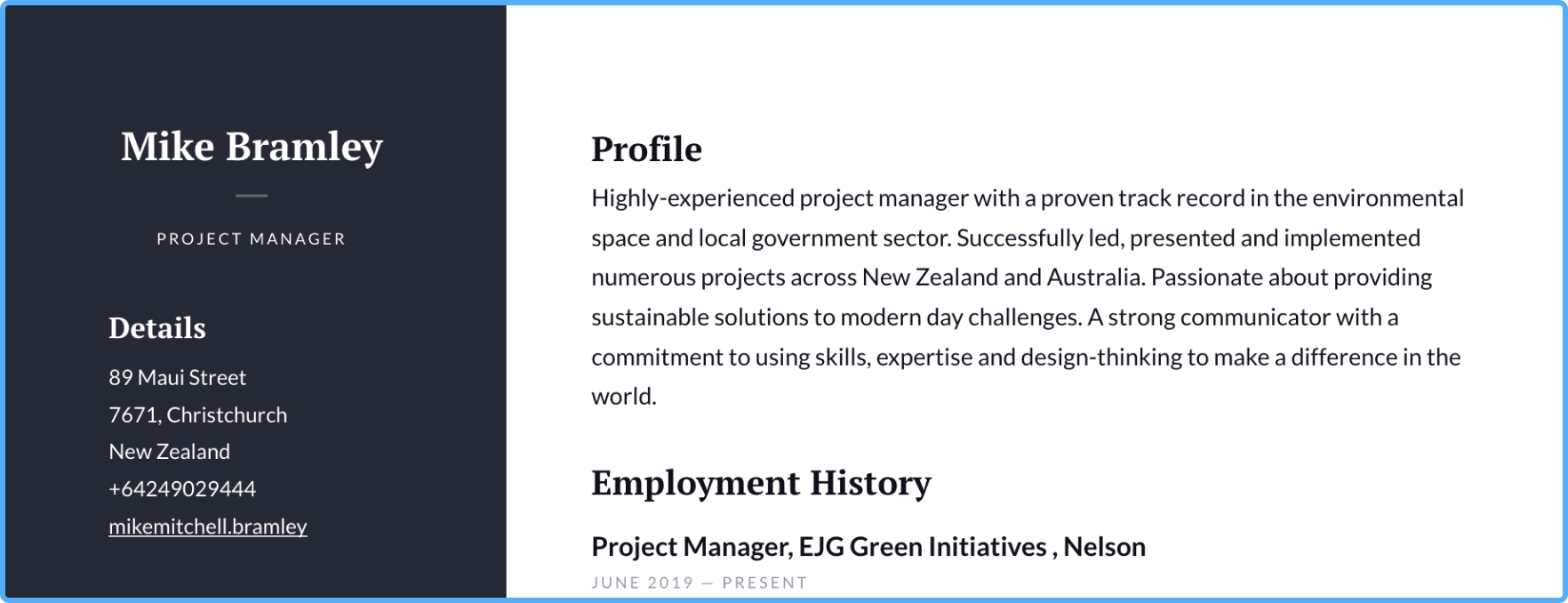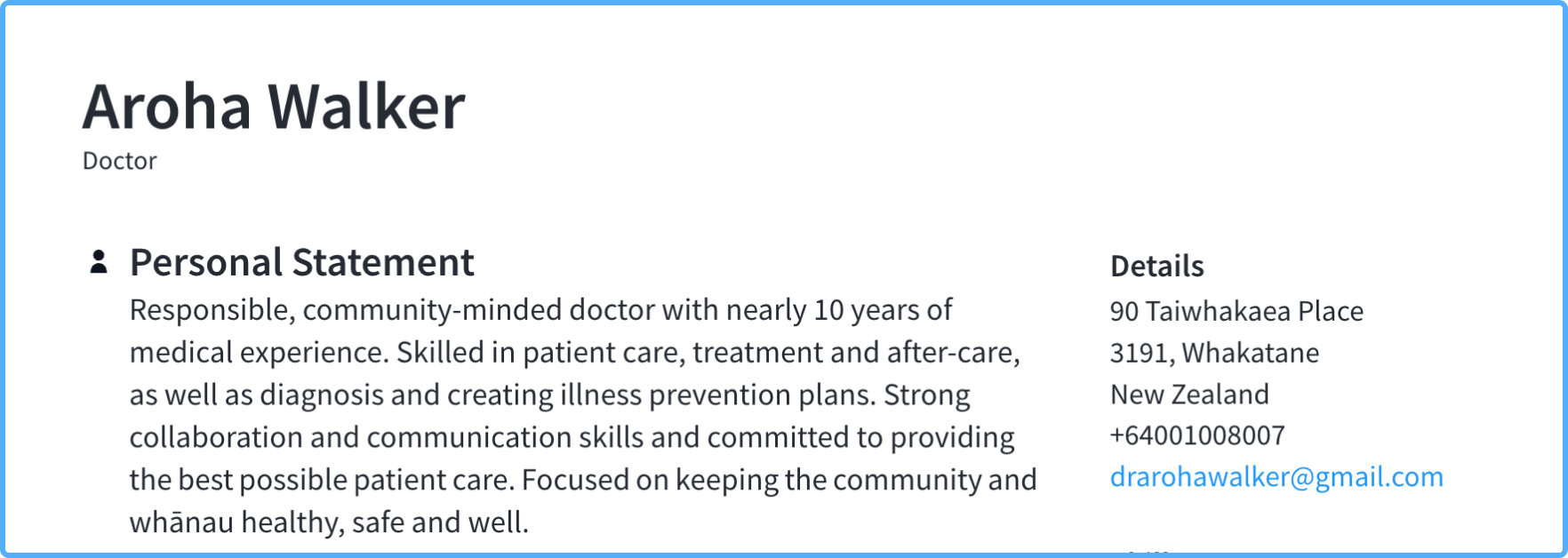Think of your CV header as your professional tagline. Positioned at the top of your CV, your CV header contains all your contact details so employers can reach out. It’s typically also the first thing recruiters see, so make it count!
A strong header gives recruiters a quick snapshot of your professional identity. It's like a mini-introduction that sets the stage for the rest of your CV. Make it compelling, and recruiters will be eager to learn more!
Why do you need a CV header?
Your CV is your first impression, so you want it to grab the hiring manager's attention right away. Ultimately, a strong header is key! Make sure your name, phone number, email, and location are easy to find. Think of it as the headline act of your CV – it needs to be clear, concise, and nearly impossible to ignore.
A sharp header does more than just list your contact info. It shows you're professional and detail-oriented – and that makes a great first impression! Use it to highlight your personal brand and what you're all about. Think of your CV header as a quick snapshot of your professional identity. Plus, a well-organised header makes your CV easy to read and navigate, so recruiters can find what they need in a flash.
Opt for a professional template with clean fonts and formatting for a polished look. Also, make sure your font works with the language you're using. Some fonts might not display characters from languages like Te Reo Māori correctly. Remember, your CV is a formal document, and your font choice should reflect that.
How do you build a CV header?
Every CV needs a strong header, but what exactly does that look like? Well, it definitely needs your full name, front and centre, in a professional font. Think 'clear and easy to read,' not 'fancy and distracting.'
Consider making your name slightly larger than the rest of the header text to make it stand out. If relevant, include a concise, professional title that reflects your career focus, such as " Physical Therapist" or " Software Developer."
Of course, your contact information is important, so ensure your phone number, email address, and location (city and country) are accurate and easy to find. You can also include a link to your LinkedIn profile so recruiters can further explore your professional background. If you have a personal website or online portfolio relevant to your field, don't hesitate to include the URL in your header.
Keep it concise: Your header should be clear, easy to read, and to the point.
Overcrowd the header: Avoid excessive information or design elements that make it look cluttered.
How do you design a good CV header?
The design of your CV header can significantly impact its effectiveness. A visually appealing header can make your CV stand out from the crowd. Firstly, think about your overall CV format. Consistency is key – ensure your header design aligns with the style and formatting of the rest of your CV.
Make good use of white space to create a clean and uncluttered look, avoiding a cramped or overwhelming header. Consider adding a subtle background colour or a simple border to help your header stand out while maintaining a professional appearance.
For example, a creative or modern CV header might include your name in a slightly larger font, followed by your professional title, and then your contact information neatly organised on a single line.
Modern Applicant Tracking Systems (ATS) are hungry for what you offer the company. Instead of incorporating a bland personal statement, supercharge your CV by weaving in keywords from the job description and instantly demonstrate your value.
Copyable CV header examples:
Now that you have a good understanding of what makes a strong CV header, let's take a look at some practical examples. These copyable CV header examples use various styles and formats suitable for different professions and career levels.
Use these examples below as inspiration and adapt them to create your own unique and impactful CV header:

This CV header example is perfect for creative roles, where highlighting technical skills and a strong portfolio is key.

This CV example uses a classic header with a neat and professional layout, including the candidate’s full name, address, phone number, and email address aligned to the left.
For more design and formatting inspiration, check out the CV header examples below:



Do I need to include my address in my header?
In today's digital age, the necessity of including your full physical address in your CV header is a topic of debate. While it was once standard practice, the rise of online applications and remote work has made some question its relevance.
On the one hand, including your address can be helpful for employers who prioritise local candidates or need to know your general location. It also adds a touch of formality and traditionalism to your CV. On the other hand, omitting your address can protect your privacy and prevent potential bias based on your location.
Ultimately, the decision depends on your individual circumstances and the specific job market you're targeting. If you're unsure, consider including only your city and country, striking a balance between providing relevant information and safeguarding your personal details.
Is a two-page CV header necessary?
When your CV spills onto a second page, it's natural to wonder how to maintain a professional and consistent look. While it might seem logical to replicate your full header, in most cases, repeating the detailed version from the first page is unnecessary and can even be detrimental. Imagine a recruiter flipping to the second page and encountering the same bulky header – it creates visual clutter and takes up valuable space that could be used to showcase your skills and experience.
However, there are instances where a second-page header can be beneficial. If your CV is quite long, spanning three or more pages, a simplified header can enhance readability and navigation. A subtle header with just your name and the page number is sufficient in these cases.
Neat headers help maintain consistency and ensure recruiters can quickly identify your CV if pages become separated while avoiding unnecessary repetition. Ultimately, the decision depends on the length and structure of your CV. Opt for a clean visual layout and err on the side of simplicity.
Consider the overall length of your CV: if it's only slightly longer than one page, a second header might not be necessary.
Key Takeaways
Bottom line: your CV header is the first thing recruiters see, so make it shine! A strong header shows you're professional, organised, and ready to impress.
Remember to focus on clarity, consistency, and a professional format to ensure your CV header serves as a compelling introduction to your candidacy. You’ve got this!




